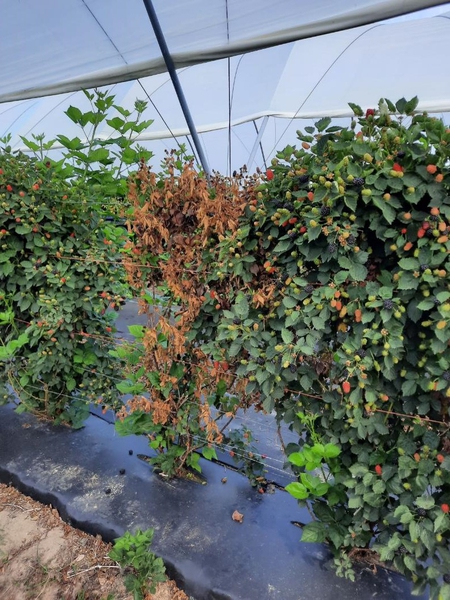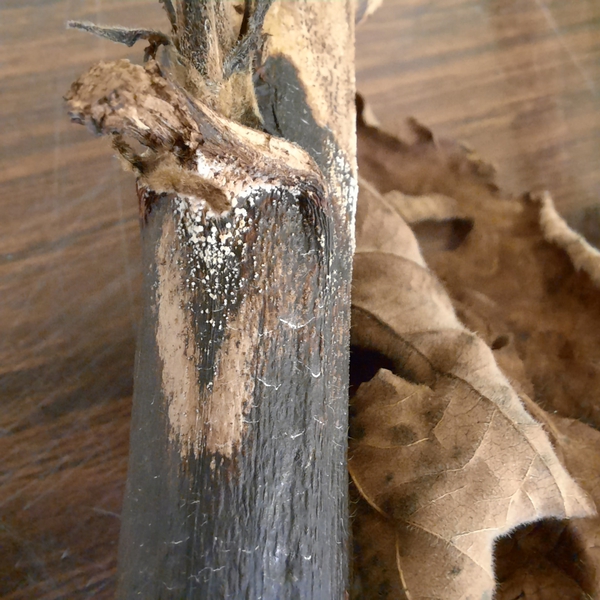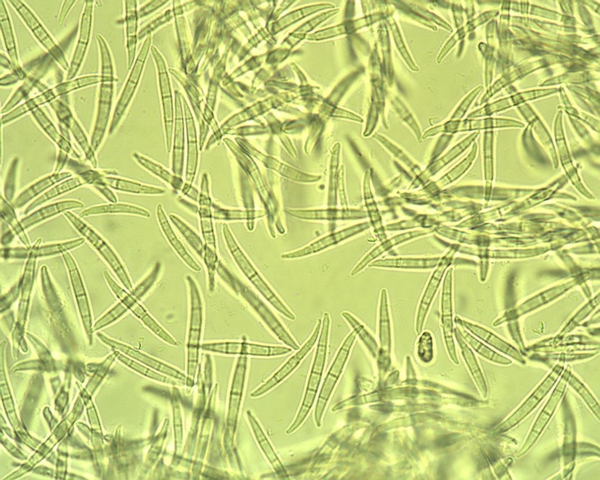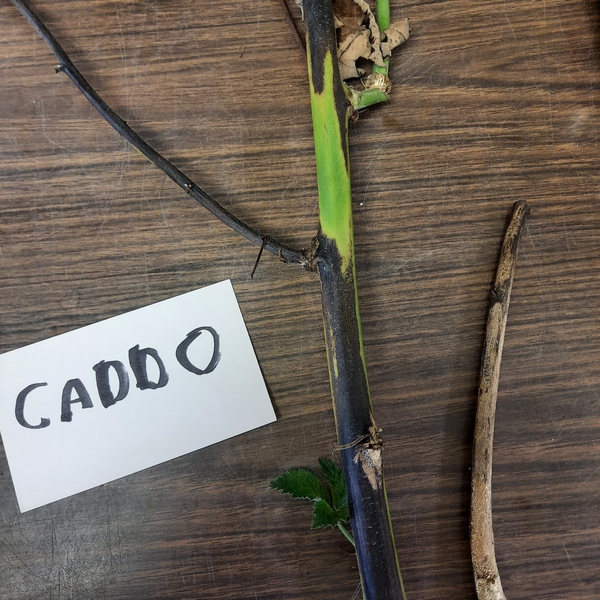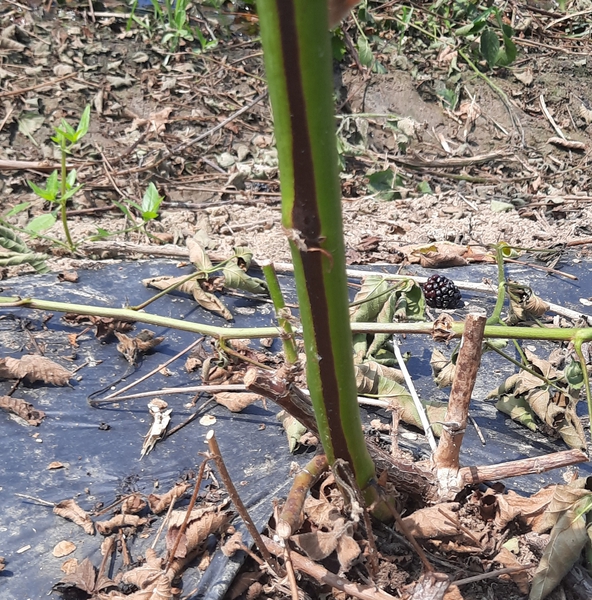Introduction
Fusarium wilt is an emerging disease of blackberry in commercial plantings in southeastern North Carolina. Fungi in the genus Fusarium are known to cause wilt diseases on plant hosts worldwide. Fusarium species are often host-specific, attacking only a single host species or group. Examples in North Carolina include wilts of blackberry, tomato, eggplant, pepper, watermelon, soybean and ornamentals. The pathogen is soil borne and can survive for years in infested soils.
General Information
Fusarium wilt has been identified on blackberry in North Carolina, in California and in Mexico. Genetic studies indicate that the Fusarium isolates from these locations are of the same genus, species and form (Fusarium oxysporum formae specialis mori) but are not genetically identical, and that the populations of the fungus within each location are diverse. Furthermore, research in California has shown that the pathogen can be frequently found in wild blackberry (Rubus spp.). This suggests that the fungus is a host-specific pathogen of wild blackberry or related wild species, and only recently has appeared as a pathogen of concern on commercially grown blackberry cultivars.
Symptoms and Signs
SYMPTOMS –
The first symptom of Fusarium wilt on blackberry is wilting accompanied by the appearance of longitudinal black streaks on canes, initially only on one side of the infected cane. This black discoloration usually begins at or near the ground. Wilted canes may die rapidly with the leaves turning brown and remaining attached to the plant. The entire plant may be killed, or in some cases only the infected canes die and the plant recovers, producing new primocanes. Recovery is usually only temporary, and the plant often dies in the second year.
SIGNS –
The fungus produces abundant spores on the surface of infected canes. These masses of spores occur in whitish-pink or tan-colored longitudinal streaks on the necrotic parts of infected canes, with spore production beginning nearest the initial infection point and spreading along the cane. The surface of the infected tissue may become entirely covered in spores as the infection progresses. Fusarium spores are multi-celled and have a distinct crescent shape that is readily identified when viewing with a microscope.
Pathogen and Disease Cycle
Fusarium wilt of blackberry is caused by Fusarium oxysporum formae specialis mori. The disease cycle is not well documented. Fusarium diseases are generally considered to be soil-borne, with infection occurring through roots. However, on blackberry the fungus produces abundant spores on the surface of canes, and these spores may also serve as a means of spread. In blackberry, infection is thought to occur via either root infection (soil-borne) or via spores infecting above-ground plant parts. Aerial spores may be spread by rain-splashing, through air movement, or may be physically transferred plant-to-plant during harvest or trellising. Soil-borne spores (chlamydospores) can be spread via soil adhering to farm equipment or worker’s shoes, or through transplanting of plants growing in infested soil.
Best Management Practices
Clean Plants – Avoid introduction of the pathogen by planting only disease-free plants from a known source. Do not transplant root pieces or plants collected from sites where the pathogen may be present in the soil.
Avoidance – Do not plant blackberries in areas where the disease has occurred previously. There may also be greater risk of endemic, blackberry-specific Fusarium in the soil on newly cleared sites where wild blackberries were abundant.
Sanitation – Remove and destroy dead or symptomatic plants and infected canes. Do not use a mower or cultivator to mulch infected canes or infected root systems in the field – instead, remove all infected crop residue from the field for burning or other disposal methods. Mowing/mulching in the field is still an acceptable method for disposing of healthy, non-infected canes following normal pruning operations.
During harvesting, trellising and pruning operations, avoid handling plants when wet. When the disease is present in one field but not others, conduct daily operations (harvesting, trellising, pruning) in the clean/healthy fields first, and in the infected plants last, to avoid spreading disease from infected plants to the healthy ones.
Fungicides – Fungicidal control has not been investigated and at this time there are no clearly beneficial fungicide applications to be recommended. Fusarium diseases are difficult to address using fungicides, especially when infection occurs from infested soil via root infection.
Fumigation – Fumigation with biocidal products creates a clean, disease-free zone in the soil that may be beneficial during plant establishment. However, once the roots grow out of the fumigated zone and into surrounding soil, infection can occur if the pathogen is present. Fumigation is likely of limited long-term value for replanting blackberries in soils where Fusarium is present.
Resistance or Tolerance – Resistance is the ability of the plant to withstand (resist) infection by a pathogen. Tolerance is the ability of plants, once infected, to survive and remain productive even though infected. Some blackberry cultivars identified as resistant to Fusarium in California appear to be susceptible to the pathogen as it occurs in North Carolina, so at this time there are no clear recommendations for resistant cultivars that could be planted in infested areas.
Publication date: Feb. 8, 2022
N.C. Cooperative Extension prohibits discrimination and harassment regardless of age, color, disability, family and marital status, gender identity, national origin, political beliefs, race, religion, sex (including pregnancy), sexual orientation and veteran status.

